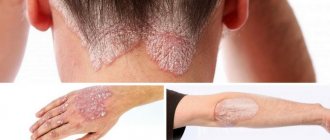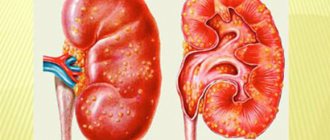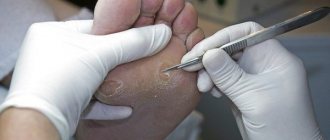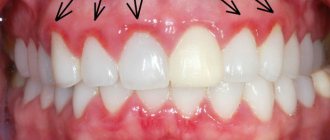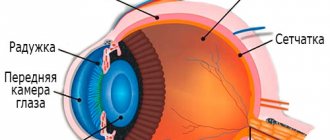Oligoasthenoteratozoospermia: the concept of the disease
The diagnosis of “oligoasthenoteratozoospermia” in medicine refers to a whole group of pathologies of spermatogenesis, the disease includes:
- Oligozoospermia - low concentration of sperm in the ejaculate;
- Teratozoospermia - more than half of abnormal sperm;
- Asthenozoospermia - the number of immotile sperm is higher than the permissible norm.
If all of these pathologies have been detected, the likelihood of conceiving a child naturally is almost zero. However, this does not mean at all that there is no chance that a baby will appear in the family; complex therapy and auxiliary techniques can help solve these problems.
Why does this happen?
The cause of asthenozoospermia can be any factor that negatively affects the functioning of the testicles and impairs the process of spermatogenesis. Some of them lead to persistent delayed consequences that persist throughout the patient’s life and after the elimination of the damaging effect. Other factors can be eliminated or corrected, improving testicular function.
The most common causes of asthenozoospermia:
- Chronic intoxication, most often caused by prolonged contact with household chemicals, petrochemicals, pesticides, fertilizers, paints and other toxic compounds. Pathology of ejaculate can also be associated with tobacco smoking, drug addiction, and substance abuse.
- Taking certain medications (cytostatics, anticonvulsants and psychotropic drugs, some antihypertensive and antibacterial drugs, steroid hormone blockers).
- Temperature conditions are unfavorable for spermatogenesis, and both hypothermia and overheating of the perineal area are important. Therefore, those at risk for asthenozoospermia are lovers of baths, saunas and hot baths, workers in hot shops, and people who often freeze (which may be due to insufficiently warm clothing in the cold season, or to the characteristics of their profession or hobby).
- Irregular intimate life with periods of prolonged sexual abstinence, which leads to changes in sperm viscosity and other physical and chemical characteristics of the ejaculate.
- Infectious and inflammatory diseases of the genitourinary system, including those caused by STDs.
- Injuries to the perineal area, previous operations on the scrotum.
- Diseases accompanied by compression of the testicles by any space-occupying formations. These can be tumors of various types, cysts, varicoceles, an inguinal hernia descending into the scrotum, or hydrocele.
- Exposure to X-ray (radioactive) radiation, electromagnetic waves.
- Genetically determined disorders of spermatogenesis.
- Chronic stress, neurotic disorders.
Diseases of the prostate gland also have a negative impact on the quality of sperm. The fact is that changes in the physicochemical parameters of prostatic juice impair the motility of sperm in the ejaculate, even in the absence of spermatogenesis disorders. Therefore, the occurrence of signs of prostate damage in men of reproductive age requires an assessment of the potential fertility of sperm.
Classification
In order to better assess the problems that are characteristic of oligoasthenoteratozoospermia, it is classified according to a group of criteria:
1. Secretory - germ cells are produced in too small quantities, in addition, they have anomalies in structure and mobility;
2. Obstructive - sperm have impaired patency through the vas deferens;
3. Immunological - occurs as a result of injury to the testicle, resulting in the production of antibodies to sperm;
4. Idiopathic - the quality of the ejaculate deteriorates due to the influence of internal and external factors.
IMPORTANT! The most important thing in seminal fluid is not the total number of germ cells, but how many sperm can reach the egg and are able to fertilize it.
Causes of asthenozoospermia
The active forward movement of the sperm is ensured by the correct shape of its body and sufficiently liquid seminal plasma - maximum ergonomics and minimal resistance. There is still no exhaustive list of reasons why germ cell mobility is impaired. Doctors are often confused and make a diagnosis of “idiopathic asthenozoospemia.” The main reasons for decreased sperm motility:
- High viscosity of seminal plasma (viscosity). A common cause is too thick prostate secretion (due to congestive prostatitis).
- Agglutination is the gluing of sperm to each other due to an increased concentration of lactic acid.
- Sperm tail defect (one of the manifestations of teratozoospermia): shape pathologies, dysplasia (improper development) of the fibrous membrane, mutations of mitochondria - the spiral filaments on which the tail is assembled (it is the mitochondria that provide the sperm with motor energy).
Sperm tail defects
- Pathogenic microorganisms (chlamydia, ureaplasma, mycoplasma) that settle on the surface of sperm, interfering with their movement.
- Genetic pathologies of sperm that are inherited.
- A low concentration of glucose in seminal plasma is the reason for a decrease in the energy potential and activity of sperm.
The factors against which the above disorders develop can be divided into two groups – external and internal. Their list is presented in Table 1.
Table 1. Factors provoking asthenozoospermia
| External | Domestic |
| Radiation and electromagnetic radiation. Surgical interventions on the scrotum. Intoxication with industrial poisons, alcohol, nicotine, narcotic substances (cells that produce sperm die). Taking medications (steroidogenesis blockers, cytostatics, digoxin, ketoconazole, anabolic steroids, cimetidine, spironolactone, psychotropic and antihypertensive drugs). Unbalanced sex life: too frequent ejaculations or their absence for a long time (sperm either do not have time to mature normally or are subject to oxidation). Stress (increases the production of cortisol, which disrupts spermatogenesis), weakened immunity. Frequent and prolonged exposure to high temperatures Use of marijuana and other drugs (hormonal balance changes towards the predominance of female estrogens). Poor nutrition. The composition of the ejaculate directly depends on the quality of food consumed. Wearing tight underwear (impaired nutrition and thermoregulation of the testicles). | Hormonal disorders, which are often provoked by obesity. Autoimmune pathologies (the body’s immunity attacks its own cells, including sperm): the presence of antisperm antibodies that stick to sperm, reduce the negative charge they carry, causing cells to stick together. Kartagener syndrome (a genetic pathology in which the functioning of the ciliated epithelium is disrupted). Viral infections, STDs. It is not so much the pathogenic agent itself that has a negative effect, but multi-stage antibiotic therapy. Epididymitis and orchitis are inflammation of the epididymis and testicles. Forms of prostatitis in which pathological changes in the gland juice occur (admixtures of pus, its thickening, disturbances in the biochemical composition). Enzymopathies are disturbances in the activity or complete absence of certain types of enzymes (without them, normal biochemical reactions during sperm synthesis are impossible). |
Stages
Depending on the number of sperm, three stages of the disease are distinguished:
Stage 1: in male seminal fluid, the number of sperm per 1 ml varies from 20 to 30 million, of which less than 50% are actively motile and sedentary with rectilinear movement.
Stage 2: 1 ml of ejaculate contains from 5 to 20 million sperm, among which from 30 to 30% are actively motile and sedentary with rectilinear movement.
Stage 3: a decrease in sperm count to 5 million or less is diagnosed, with actively mobile and sedentary ones with linear movement from 10 to 20% of their number.
When it's not really bad
There are three stages of the disease, which are characterized by the percentage of different types of sperm in the ejaculate.
According to WHO documents, male gametes are usually divided into classes:
- Progressively mobile, with rectilinear movement (class A).
- Progressively weakly mobile, moving straight (B).
- Non-progressively mobile, with a pendulum-type movement (C).
- Immotile sperm (D).
The norm for successful conception is the presence in sperm of at least 20% of class A sperm and more than 50% of class A and B sperm. A decrease in the number of active full-fledged male gametes is the number 1 cause of male infertility.
Fertilization of the egg directly depends on the number of normal “fast” sperm; a decrease in their number, which is observed with asthenozoospermia, is the cause of male infertility, which is often considered as a temporary phenomenon.
The chance of fertilization directly depends on the number of healthy and motile sperm.
The patient’s treatment tactics and reproductive prognosis depend on the degree of manifestation of spermatogenesis disorders. Asthenozoospermia occurs:
- Weakly expressed: is set in the case when at least 50% of progressively motile gametes of classes A and B are detected.
- Moderate: the number of full sperm A+B is reduced to 30-40%. With such spermatogram indicators, a man’s chances of successful conception are sharply reduced, but his partner’s pregnancy is quite possible. The man must be further examined and treated.
- Pronounced: active gametes A and B in sperm are less than 30%, there is a predominance of defective sperm of classes C and D.
A severe stage of impaired spermatogenesis in a man is a serious obstacle to the pregnancy of his partner.
Doctors distinguish another fourth stage of asthenospermia, in which 10% of immobile (dead) gametes are found in the ejaculate. Such a high percentage of “non-living” sperm leads to an undesirable “chain reaction”:
- The accumulation of “corpses” of sperm, leading to the formation of pus and mucus in the ejaculate.
- Acidification of sperm and death of the remaining, already small, sperm.
The chance of getting pregnant with stage 4 of the disease, although small, still exists, so a man should not refuse treatment. By giving up his hand and stopping the fight for the opportunity to have offspring, he will deprive his woman of her last hope of giving birth to his child.
Treatment
Treatment methods for asthenozoospermia depend on the identified pathology. In the absence of genetic abnormalities, the prognosis is favorable. Treatment is mainly medication . Microsurgical methods are used for hydrocele, varicocele, and the presence of other disorders of the structure of the testicles and vas deferens. Hormonal drugs are used to correct endocrine abnormalities.
In some cases, the physiological causes of asthenozoospermia cannot be found, then a three-month course of nonspecific treatment (physiotherapy, dietary supplements) is prescribed. This duration of therapy is due to the need to completely renew the set of sperm (on average 72 days).
You can increase sperm motility with the help of the amino acids L-carnitine and acetyl-L-carnitine (carnitine). These conclusions were made based on numerous studies. Examples of sources: Andrologia 1994, no. 26, pp. 155-159, Androl 1984, no. 7, pp. 484-494, Acta Eur Fertil 1992, no. 23, pp. 221-224. L-carnitine is necessary to provide germ cells with energy. In small doses, acid is present throughout the body, including in the epididymis. The daily need for L-carnitine is 200-500 mg, depending on the level of psycho-emotional and physical stress, for carnitine – 1000 mg. Acetyl-L-carnitine and L-carnitine also protect sperm from oxidative damage.
Dietary supplements with plant extracts, vitamins and amino acids:
- "Speman";
- "Spermactiv";
- "Profertil";
- "Speroton";
- "Androdosis."
To provide a favorable environment in the vagina and increase sperm activity, you can use the intimate gel "Aktifert". The active substance is the natural carbohydrate arabinogalactan. Suitable for long-term use, but in some women it causes itching and swelling of the vagina - a consequence of individual intolerance.
The following methods of physiotherapy for asthenozoospermia are used:
- Plasmapheresis – blood purification. Effective for autoimmune infertility (presence of antisperm antibodies on sperm).
- Myostimulation of the pelvic area to increase blood flow.
- Hirudotherapy (treatment with leeches). Active substances thin the blood, enriching it with antibacterial and bioactive components.
Among the traditional methods for the treatment of asthenozoospermia, beekeeping products are effective: royal jelly, beebread, propolis, a mixture of honey and nuts. To strengthen the immune system, take tinctures of ginseng and eleutherococcus roots.
Recently, psychosocial factors have played an increasingly important role in spermatogenesis disorders; some patients are recommended to consult a psychologist or psychotherapist.
Causes
There are many reasons that provoke the occurrence of pathology, however, the main ones are varicocele (18% of cases), physical inactivity (10%), and genitourinary infections (8%). Unfortunately, in almost a third of cases, provoking factors cannot be identified.
The disease can also be caused by:
- congenital anomalies of the genital organs,
- kidney and liver diseases,
- diabetes,
- pathology of the thyroid gland,
- drug addiction and alcoholism,
- genetic predisposition,
- unfavorable working or living conditions - chemical and radiation exposure,
- testicular aplasia,
- venereal diseases,
- tuberculosis, typhus, mumps,
- taking antidepressants and tranquilizers,
- gigonadism,
- stress.
In most cases, oligoasthenoteratozoospermia occurs as a result of a combination of several unfavorable factors.
IMPORTANT! If a boy suffered from mumps in childhood, then during puberty he should consult a urologist, and during pregnancy planning, visit an andrologist.
Causes of the disease
If, as a result of a spermogram, a man is diagnosed with asthenozoospermia, the causes of which can be very diverse, it is imperative to establish why sperm activity is reduced.
There are a number of factors that can provoke the development of asthenozoospermia:
- Negative effects of alcohol, drugs or certain medications.
- Genetic abnormalities in the structure of sperm.
- Aggressive exposure to electromagnetic or radiation waves.
- Prolonged stay in places with too high or too low temperatures.
- Prolonged sexual abstinence, irregular sex life.
- Various diseases and inflammations of the genital area.
- Poor environmental conditions, frequent stress, nervous tension.
- Decreased immunity level.
Also, the causes of the disease may be associated with various sexually transmitted infections. Most often we are talking about infections such as ureaplasma, mycoplasma, and chlamydia.
Read more about the treatment of ureaplasmosis in men here, how to get rid of chlamydia -.
Very often, the occurrence of asthenozoospermia is associated with other diseases of the male reproductive system, for example, chronic prostatitis or other diseases of the prostate gland, varicose veins of the testicles, and injuries to the genital organs.
Only a doctor can determine the cause of the disease, who will prescribe all the necessary tests and laboratory tests.
The effect of oligoteratozoospermia on fertility
Oligoteratozoospermia is characterized by a decrease in the concentration of sperm in the seminal fluid and a violation of their activity. In order for natural fertilization to occur, 1 ml of ejaculate must contain at least 15 million active sperm. Only sperm with normal activity can overcome the acidic environment of the vagina, reach the fallopian tubes and fertilize the egg. If there are not enough motile cells in the seminal fluid (less than 40-50%), fertilization can be difficult - only healthy sperm can penetrate the membrane of the female reproductive cell. The likelihood of getting pregnant in this case is significantly reduced.
Pregnancy with asthenozoospermia
The consequences of pregnancy against the background of asthenozoospermia depend on the cause of the pathology. If the problem is a violation of the structure of sperm, then a frozen pregnancy, miscarriage, or deviations in the development of the embryo are possible. To minimize the risk of such an outcome, it is necessary to undergo a course of treatment before conceiving. If it does not help, then artificial insemination remains, preferably with high-quality pre-implantation diagnostics.
Artificial insemination methods:
- Intrauterine insemination is the introduction of pre-selected sperm into the uterus using a narrow flexible catheter. Used for mild asthenozoospermia (PR more than 10%).
- IVF with husband's sperm is the natural fertilization of extracted eggs with selected active sperm in vitro. The method is effective for moderate asthenozoospermia (PR more than 5%).
- IVF in combination with ICSI involves the introduction of sperm directly into the egg for the subsequent formation of an embryo and its implantation into the uterus. The method is effective even with severe asthenozoospermia.
- IVF + ICSI using donor sperm. Used when the previous method is ineffective, Kartagener syndrome.
For artificial insemination, the most viable, active sperm are selected.
Treatment tactics
The entire process of restoring the qualitative and quantitative parameters of the spermogram can be described as carrying out procedures aimed at eliminating the causes of the disorder, as well as stimulating sperm motility.
If the pathological condition is based on an inflammatory process - a specific or nonspecific infection, antibacterial agents, immunomodulators, and vitamin complexes are recommended to eliminate it. In some cases, they resort to physiotherapy, as well as hormonal drugs.
Tribestan has proven itself to be excellent . Thanks to timely, correct administration of the drug, it is possible to:
- increase the release of sex hormones;
- improve spermatogenesis;
- eliminate erectile dysfunction;
- increase the quality and quantity of sperm;
- adjust the activity of the nervous system;
- activate blood circulation in the pelvis.
Congenital anomalies of the reproductive organs require surgical intervention. Its volume and timing are also determined by the specialist on an individual basis.
Genetic autoimmune forms of the disorder do not respond to even the most modern methods of treating sperm immotility. Therefore, their course is excluded by doctors in the first place.
It is quite possible to combat oligoasthenozoospermia. It is better to check the optimal measures with your doctor.
What is asthenozoospermia
Depending on the quantitative ratio of sperm in the ejaculate, three degrees of asthenozoospermia are distinguished:
- 1st degree – mild with the number of motile sperm of groups A and B less than 50%. The fertilizing potential of sperm remains high; only minor correction is required, eliminating the causes causing a “defect” in sperm quality;
- 2nd degree – moderate with the number of motile sperm of groups A and B less than 30–40%. In this case, a thorough examination is necessary to identify the causes of the development of the disorder and get rid of them;
- 3rd degree – pronounced with the number of active sperm of groups A and B less than 30% and the predominance of sperm of groups C and D. This form of pathology requires a thorough examination and long-term restoration of spermatogenesis.
Causes of the disease
The causes determine the therapeutic measures. Your doctor may need additional tests. And the patient will have to develop new, healthier habits, a different approach to life, its joys and sorrows, ups and downs.
- Genetically determined deformity
You can't argue with genetics. With such a diagnosis, artificial insemination is the only way out.
- Unhealthy adhesion of healthy sperm
Sperm agglutination can be true or false. In the first case, the “tadpoles” stick together with each other, in the second - with epithelial cells and other components of the seminal fluid. This is a consequence of a violation of the blood-testis barrier on the surface of the living creatures (Sertoli cells).
The blood-testis barrier gives the living cell protection from the immune system, which sees sperm as an enemy and produces specific proteins - anti-sperm bodies - to neutralize them. They are located on the unprotected surface of their body and change the electrical potential, causing them to stick together. The reasons for the development of pathology are sometimes banal. This includes testicular trauma, surgeries on the organs of the reproductive system, inflammatory processes, and various infections. But sometimes they are quite serious: a consequence of disturbances in the functioning of the hypothalamic-pituitary system or an additional symptom of another disease, for example, varicocele.
- Presence of bacteria in seminal fluid
The phenomenon is called bacteriospermia in medicine. In the male genital organs, especially in the anterior urethral canal, there are always a lot of bacteria and they naturally come into contact with sperm. Sometimes their number exceeds the norm. They suddenly begin to multiply intensively or enter the penis from the microflora of the female vagina. Another way into the genitals is during anal sex.
The presence of bacteria is a pathological phenomenon. It seeks to prevent the alkaline environment of the urethra, which inhibits bacteria, inhibits their growth and partially neutralizes them. The penis is designed so that bacteria do not enter the urethra and do not multiply in this microflora.
- Changes in sperm composition
One of the reasons is inflammatory processes that prevent the prostate and seminal vesicles from functioning normally, general poor health, vitamin deficiency, and exhaustion.
With proper nutrition, it is sometimes possible to restore the natural composition of sperm and start the regeneration mechanism. But it is advisable to undergo a comprehensive examination to find out whether there are any pathologies in the prostate, seminal vesicles, and organs of the genitourinary system. If there are problems, the sooner they are detected, the better.
- Change in alkaline environment
In the chronic form of inflammation, there are no pronounced symptoms, but unfavorable processes do not fade away and gradually undermine health. Also, the cause of changes in sperm pH may be an acute inflammatory process of the accessory glands. A change from an alkaline environment to an acidic one is a symptom of blockage of the vas deferens of both seminal vesicles or the congenital absence of these ducts. Sperm can have a sharply alkaline environment. This happens with prostate pathologies. Normal pH values are 7.2-8.0.
- Alcohol, smoking and other negative influences
Drinking strong drinks, for example, ensures that ethanol enters the bloodstream. Ethanol enters the sperm within a few hours - from 3 to 12. This substance reduces the activity of sperm and has a detrimental effect on health. Of course, it’s difficult to call alcohol a form of contraception. But with certain individual characteristics, alcohol can be a source of infertility.
Numerous experiments and experiments confirm the fact that smoking has a bad effect on seminal fluid:
- its volume decreases during ejaculation;
- sperm concentration decreases;
- DNA fragments as a result of the action of nicotine.
Tobacco smoking, again, is not a means of contraception, but it reduces a man’s chances of procreation.
Symptoms of sperm sluggishness
The disease has no obvious symptoms
In advanced cases, azoospermia may develop, when the percentage of active livestock is zero, i.e. the man is infertile.
Diagnostics
The diagnosis is made based on the results:
- spermograms;
- Ultrasound of testicles, prostate;
- studies of the patency of the vas deferens;
- genetic research;
- Dopplerography of the scrotum;
- tests to detect infectious diseases;
- determining the type of prostate secretion.
Spermogram and its interpretation
The analysis is not cheap, but it is still affordable for most people. It is not always easy to pass because it is associated with moral discomfort. But the high information content of the analysis outweighs all the negativity from its implementation.
- Firstly, it will give an idea of whether it is asthenozoospermia at all.
- Secondly, it can show the level of pathologically formed sperm in the total number. Sometimes they have an abnormal structure of the tail and head, which indicates important disorders in the male body. How serious they are will be shown by further research and analysis.
- Thirdly, a spermogram can provide information about the development of pyospermia. With it, the level of leukocytes changes. It indicates inflammatory processes in the man’s body. It could be prostatitis, vesiculitis or something else.
- Fourthly, this analysis will help determine the causes of problems with sperm activity.
The results of the examination must be assessed by a specialist in combination with other clinical data. However, anyone has the right to study the indicators themselves and compare them with the recommended norm.
Here are the main WHO spermiological indicators:
- The volume of sperm obtained per ejaculation ranges from 2 to 5 ml. If the ejaculate volume is less than 2 ml, this is called “microspermia” and indicates insufficient activity of the accessory sex glands, especially the prostate. It can also be caused by retrograde ejaculation (flow of sperm into the bladder), decreased patency of the genital tract, underdevelopment of sexual characteristics, and a short period of abstinence. According to WHO standards, there is no upper volume limit. However, there is an opinion that an increase of more than 5 ml may be a sign of inflammation of the prostate or seminal vesicles.
- The color is greyish, but a yellow tint is also acceptable. Yellowishness may be a sign of jaundice or indicate taking vitamins (usually vitamin A) or foods (carrot juice).
- pH 7.2 or higher.
- The time it takes for the sperm to become liquid should be no more than 60 minutes. If the ejaculate remains viscous for a long time, it impedes the movement of tadpoles, traps them in the vagina and sharply reduces their fertilizing properties. The reasons for the slow liquefaction of the ejaculate are inflammation of the accessory sex glands (prostatitis, vesiculitis) or enzyme deficiency.
- 1 ml should contain more than 20 million sperm. If the number is more than 120 million, it is “polyzoospermia.” The causes of this condition may be endocrine disorders, poor circulation of the genital organs, the influence of toxins or radiation, inflammation, and less commonly, immune pathology.
- The total sperm count of 40 million or more is the number of cells in 1 milliliter multiplied by the volume of ejaculate. Extreme normal figures are 40-600 million.
- There are 4 groups: A – active, moving straight; B – with low mobility, moving straight; C – with low mobility and incorrect movements; D – not making movements. Normally, an hour after ejaculation, group A makes up more than a quarter of all cells, or groups A and B make up more than half. The content of C and D is allowed no more than 20% each.
- The content of structurally normal sperm capable of fertilization must be at least 15%. Usually from 40 to 60% of all cells, but this figure greatly depends on the method of examining the smear. Teratospermia is a condition when there are less than 20% normal cells.
- The content of living creatures in the ejaculate must be at least 50%. A decrease in this indicator is called “necrospermia”. This diagnosis is evidence of severe disorders of sperm formation.
- Immature germ cells are found in every analysis. An increase of more than 2% may indicate a secretory form of infertility.
- There should be no agglutination in the spermogram, or sperm sticking together. This is a rare phenomenon, a consequence of immune disorders. Aggregation is the formation of complexes not only from sperm, but also from other elements (leukocytes, erythrocytes). It occurs due to their gluing with mucus and has no diagnostic value. Agglutination is often a sign of the presence of antisperm antibodies, which can be present in both men and women and cause immune infertility (incompatibility of partners). They are determined by the immunochemical method (MAR test).
- There are always leukocytes in the ejaculate, but there should be no more than a million of them (3-4 in the field of view). Excess is a sign of inflammation of the genital organs (prostatitis, orchitis, vesiculitis, urethritis and others).
- There should be no red blood cells in the ejaculate. Blood in the spermogram may appear due to tumors of the genitourinary system or urolithiasis. This sign requires serious attention.
- The absence of amyloid bodies indicates a decrease in prostate function. Lecithin grains characterize the function of the prostate; their absence indicates some kind of disorder.
- Mucus may be present in small quantities. An increase in its volume is a sign of inflammation in the genital tract.
Prevention
To improve sperm quality and increase its activity for men, it is recommended:
- give up bad habits - smoking, abuse of alcoholic beverages, toxic or medications;
- have a regular sex life, without long periods of abstinence and increased sexual activity. It is best if every sexual contact ends in ejaculation;
- avoid promiscuity; when having sexual intercourse with a casual partner, you must use contraception;
- adhere to the basic rules of a healthy diet - eat more fresh vegetables, fruits and berries, cereals, lean meats and fish, dairy products, exclude strong black coffee and alcoholic drinks, spicy, fried, fatty and pickled foods, all semi-finished and fast foods from your diet -food
Urologist-andrologist Andrey Aleksandrovich Lukin talks about methods of improving fertility:
How to treat oligoteratozoospermia
In the event that the development of pathology is provoked by inflammatory diseases or infections, the man is prescribed medications. The most common means are:
- Menogon;
- Tribestan;
- Spermactin;
- Pentoxifylline.
The main properties of these drugs are:
- improving blood supply to the genitals;
- fight against inflammation and infectious diseases;
- creating conditions for proper sperm maturation;
- normalization of the reproductive system;
- increased testosterone levels in the blood;
- an increase in the number of active sperm in the seminal fluid and an increase in their activity.
Diagnosis of asthenozoospermia
Asthenozoospermia is, in fact, not a diagnosis, but a symptom. For successful treatment it is necessary to identify the source of the pathology. Diagnostic methods used:
- Ultrasound of the scrotum and prostate.
- Calculation of body mass index to determine the degree of obesity.
- Assessment of hair growth in androgen-dependent areas.
- Examination of inguinal lymph nodes.
- To detect antisperm antibodies, highly sensitive tests are performed: ImmunoBead test and MAR.
Read more about the procedure for conducting a MAP test, embryologist Tatyana Vladimirovna Dubko
- Analysis of sperm morphology.
- Clinical and biochemical blood test.
- Hormonal profile assessment: estradiol, prolactin, total testosterone, follicle-stimulating hormone.
- A smear from the scaphoid fossa of the urethra for subsequent PCR testing.
- Bacterial culture of ejaculate.
Diagnostics allows us to identify pathologies of the reproductive system, the presence of infections, and hormonal abnormalities.
Disease prevention
Before planning to conceive a child, it is necessary to pay special attention to the quality of seminal fluid. To do this, it is necessary to exclude unfavorable factors that negatively affect sperm production. Therefore, a man must adhere to these rules:
- get rid of bad habits such as smoking and excessive consumption of alcoholic beverages;
- balanced diet;
- active lifestyle;
- moderate physical activity;
- timely treatment of diseases of the genitourinary system.
It is also necessary to regularly visit a urologist for preventive purposes. This must be done at least once every six months.
Oligoasthenoteratozoospermia is a disease that is treatable, especially with timely treatment. Therefore, when establishing such a diagnosis, you should not give up, since the prognosis for treatment is predominantly positive.
Prevention
The main method of prevention is to prevent those factors that can affect the quality and activity of sperm. To do this, first of all, it is necessary to undergo regular scheduled inspections, which will help identify potential threats and begin to combat them.
Otherwise, the disease may develop into a chronic form, which will aggravate the situation and affect the reproductive capabilities of the man.
You should also protect yourself from harmful factors, radiation and prolonged stay in places with high temperatures. Monitor the activity of your intimate life: long-term abstinence has a negative impact on the condition of sperm.
© 2020 — 2020, Eganov Egan Pavlovich. All rights reserved.
Probability of conception
Is it possible to get pregnant with asthenozoospermia? This is not really a man's question. The answer worries many women whose spouses have been given a similar diagnosis. If possible, how soon and what measures should be taken to increase the chances of successful conception?
The chance of conceiving a child at the last stage of the disease is 5%.
Reviews from reproductive doctors on this matter are quite encouraging.
It is possible to get pregnant with such a pathology, but the percentage of probability depends on the stage of the pathology, as well as on the man who has to take serious care of his health and sometimes change his life and give up bad habits.
According to experts, the possible pregnancy rate in the first stage of the disease is 50%, in the fourth stage it is close to 5%. As you can see, even in the most seemingly hopeless cases, there is a chance to get pregnant and give birth to a healthy baby.
50/50 - this does not mean that conception will occur immediately on the second try, it means that out of every hundred married couples, half can be lucky the first time, the rest need to continue treatment.
The chance of getting pregnant directly depends on the degree of the disease; the less pronounced asthenospermia, the easier it is to cope with it and the higher the likelihood of a long-awaited conception.
For a man of reproductive age, asthenospermia is unpleasant and unexpected news, which can “knock out” even the very best man. Therefore, a lot depends on a woman whose partner is unlucky. Her support, understanding and patience will help the stronger half in treatment, and the long-awaited pregnancy will definitely come soon.
Review Reviews
Reviews about the treatment of asthenozoospermia with various drugs can be found on women's forums, for example:
- https://www.babyblog.ru/theme/kak-uvelichit-podvizhnost-spermatozoida;
- https://www.baby.ru/community/view/22621/forum/post/568899249/;
- https://www.babyplan.ru/questions/95139-u-kogo-muzh-lechilsya-chtoby-povysit-aktivnost-spermatozoidov/.
Many people praise dietary supplements: “Spermaktiv forte”, “Verona”, “Tribulus”, “Speman”. According to reviews, after them, sperm motility increases by 10% or more after just 2 months. The degree of effectiveness of these drugs is different for each man. Some people don’t like the vaunted “Speman”, but like “Spermstrong”. Despite the high cost, the vast majority of forum participants did not notice any effect from Spermactin - sperm activity did not increase. The above dietary supplements, as a bonus, improve the quality of sexual intercourse and enhance libido.
Many with asthenozoospermia were helped by a course of vitamins C, E, folic acid (more about the dosage and preparations of folic acid for men), zinc, arginine, riboxin and selenium. Among the folk methods, elecampane decoction, beekeeping products, nuts, sour cream, seafood, pumpkin seeds, and dried fruits received positive reviews. These products not only increase motility, but also improve sperm morphology.
Men whose asthenozoospermia is provoked by prostatitis are helped by the drugs “Prostate Forte”, “Prostatilen”, as well as rectal mud tampons, electrophoresis, leeches.
Clinical course of asthenozoospermia
What is asthenozoospermia?
This is a pathological condition in which the number of viable active livestock in a man’s sperm is reduced. There are spermatozoa and there may be a lot of them, but they are immobile, inactive, move along the wrong trajectory, and their speed is greatly reduced. Only in laboratory conditions can one determine how motile sperm are. But it has already been proven that more than 40% of married couples cannot conceive a child precisely because of this pathology. The cause of infertility may lie in the increased acidity of the uterine mucosa (popularly called “incompatibility between husband and wife”), leading to the death of the living creatures; this problem can be eliminated; it is enough to treat the woman.
In the laboratory, three degrees of asthenozoospermia are distinguished:
- Weakly expressed. The ejaculate contains at least half of the active living creatures.
- Moderate. Sperm contains about 30%-49% of spermatozoa that move actively and in a straight line.
- Strongly expressed. There are less than 30% of active living creatures, the rest move more in place than strive forward.
The laboratory technician assesses the degree of pathology, focusing on the classification of motility, which is represented by four classes: A, B, C, D. According to WHO, sperm motility may have the following features (in order of worsening):
- Zhivchiki move in a straight line, actively.
- Weakly motile sperm, moving straight but slowly.
- Spermatozoa moving along the trajectory of a pendulum.
- Zhivchiki making movements in place, in a spiral.
- Absolutely immobile sperm.
According to some patients, with oasthenozoospermia they were able to conceive a child. It is believed that the presence of even one actively moving live animal gives a couple a chance to get pregnant.


